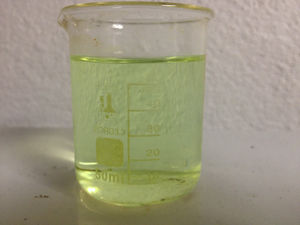Sodium hypochlorite
 Store-bought concentrated bleach
| |
| Names | |
|---|---|
| IUPAC name
Sodium hypochlorite
| |
| Other names
Bleach
Sodium oxychloride | |
| Properties | |
| NaOCl | |
| Molar mass | 74.442 g/mol |
| Appearance | Pale yellow-greenish powder (solid) Pale green liquid (solution) |
| Odor | Chlorine-like |
| Density | 1.11 g/cm3 |
| Melting point | 18 °C (64 °F; 291 K) (pentahydrate) |
| Boiling point | 101 °C (214 °F; 374 K) (decomposes); decomposition begins above 40 °C |
| 29.3 g/100ml (0 °C) | |
| Solubility | Reacts with alcohols, ketones |
| Acidity (pKa) | 7.5185 |
| Thermochemistry | |
| Std enthalpy of
formation (ΔfH |
-347.1 kJ/mol |
| Hazards | |
| Safety data sheet | Merck |
| Related compounds | |
| Related compounds
|
Lithium hypochlorite Potassium hypochlorite Calcium hypochlorite |
| Except where otherwise noted, data are given for materials in their standard state (at 25 °C [77 °F], 100 kPa). | |
| Infobox references | |
Sodium hypochlorite is a chemical compound with the formula NaClO. It is composed of a sodium cation (Na+) and a hypochlorite anion (ClO−); it may also be viewed as the sodium salt of hypochlorous acid. When dissolved in water it is commonly known as bleach or liquid bleach, and is frequently used as a disinfectant or a bleaching agent.
Contents
[hide]Properties
Chemical
The dry powder is highly unstable and shock sensitive, it is always used in solution. Sodium hypochlorite is highly reactive and a potent oxidizer. It reacts with acids to form chlorine gas, ketones to form chloroform, ammonia to form chloramines, and with various other compounds, both organic and inorganic. Sodium hypochlorite should not be mixed with another chemical unless either the reaction is already researched or it is done on a small scale in a fume hood or outside. At very high temperatures and concentrations, sodium hypochlorite reacts with itself in a two-step disproportionation reaction that proceeds as follows:
- 2 NaOCl → NaClO2 + NaCl
- NaOCl + NaClO2 → NaClO3 + NaCl
For a net reaction of:
- 3 NaClO → NaClO3 + 2 NaCl
The formation of sodium chlorate in this manner is useful for the production of the more useful potassium chlorate by addition of potassium chloride solution. If sodium chlorate is desired, a solution of sodium hypochlorite should be boiled down until only as much water is left to form a 25-30% solution by mass. However, by this time, it will not be a solution of sodium hypochlorite but of the chlorate and chloride.
Physical
Solid sodium hypochlorite appears as a greenish-yellow solid (pentahydrate) crystals. In solution, it is usually a light green liquid with a sweet, chlorine smell.
Availability
Can be easily bought as "Household bleach" in a 3-8% solution. "Spill-less bleaches" contain a surfactant, rendering them useless for many chemistry endeavours.
Preparation
It is prepared industrially by electrolysis with minimal separation between the anode and the cathode. The solution must be kept below 40 °C (by cooling coils) to prevent the undesired formation of sodium chlorate.
- Cl2 + 2 NaOH → NaCl + NaClO + H2O
Hence, chlorine is simultaneously reduced and oxidized; this process is known as disproportionation.
Another route to produce sodium hypochlorite involves passing chlorine gas through a solution of sodium hydroxide, all the way to completion of the reaction, but this is not very efficient.
Commercial solutions always contain significant amounts of sodium chloride (common salt) as the main by-product, as seen in the equation above.
Projects
- Chlorine generation, by slow addition of a strong oxidizing agent or acid
- Make chloroform
- Make potassium chlorate
Handling
Safety
Open containers of sodium hypochlorite release chlorine gas over time, and the solution itself releases hazardous compounds upon reaction with many substances. As such, the addition of sodium hypochlorite to any other substance should be researched ahead of time or done in a controlled environment on a small scale; intentionally mixing chemicals without a knowledge of what will happen can be deadly if not carried out carefully. It should go without saying, but bleaching solutions containing sodium hypochlorite will bleach most clothing, so plan accordingly.
Storage
Sodium hypochlorite solutions should be stored in closed bottles, away from any chlorine corrosion susceptible materials.
Disposal
Bleach solutions can be neutralized with hydrogen peroxide. Bisulfites, metabisulfites or thiosulfites can also be used.
NEVER USE ACIDS TO NEUTRALIZE BLEACH! The reaction releases chlorine gas which is highly toxic.
